Abstract
The proton conductivity and structural properties of (1–x)CsH2PO4–xZnSnO3 composites with compositions of x = 0.2–0.8 were studied. Zinc stannate ZnSnO3 was prepared by the thermal decomposition of zinc hydroxostannate ZnSn(OH)6, which was synthesized by hydrolytic codeposition. To optimize the microstructure of ZnSnO3, thermal decomposition products of ZnSn(OH)6 were characterized by thermal analysis and X-ray diffraction, Fourier transform infrared spectroscopy, low-temperature nitrogen adsorption, and electron microscopy. The study reveals that the thermolysis of ZnSn(OH)6 at temperatures of 300–520 °C formed an X-ray amorphous zinc stannate with a high surface area of 85 m2/g possessing increased water retention, which was used as a matrix for the formation of the composite electrolytes CsH2PO4–ZnSnO3. The CsH2PO4 crystal structure remained in the composite systems, but dispersion and partial salt amorphization were observed due to the interface interaction with the ZnSnO3 matrix. It was shown that the proton conductivity of composites in the low-temperature region increased up to 2.5 orders of magnitude, went through a smooth maximum at x = 0.2, and then decreased due to the percolation effect. The measurement of the proton conductivity of the ZnSnO3–CsH2PO4 composites revealed that zinc stannate can be used as a heterogeneous additive in other composite solid electrolytes. Therefore, such materials can be applied in hydrogen production membrane reactors.
1. Introduction
Materials based on the oxide systems Zn–Sn–O possess numerous functional properties and are thus of growing interest to researchers. For instance, zinc stannate has recently been utilized as anode material for sodium-ion and lithium-ion batteries [1,2,3]. Additionally, several works [4,5,6] have highlighted the potential for stannates as materials for supercapacitors and solar cell electrodes. Because of its chemical reactivity, excellent electronic properties, and perovskite structure, ZnSnO3 is widely used for gas and organic compound sensors [7,8,9,10,11,12,13,14,15,16,17,18,19,20]. Zinc stannates also have numerous applications in electronics, catalysis, and photocatalysis [21,22,23,24,25,26,27].
In the Zn–Sn–O system, zinc metastannate ZnSnO3 and zinc orthostannate Zn2SnO4 are present. Zinc metastannate ZnSnO3 has an orthorhombic elementary lattice with a perovskite-like crystal structure, while zinc orthostannate Zn2SnO4 has a cubic lattice with a spinel-type structure. Various methods are used to obtain these compounds, including low-temperature ion exchange, sol–gel technology, and coprecipitation followed by thermal treatment [4,28,29,30,31,32]. Among them, the sol–gel method is the most commonly used approach due to its ease of control, low-temperature, and high efficiency for obtaining various homogeneous nanostructures. However, for practical applications, coprecipitation is typically used as it is a more readily available and easy-to-implement method. Previously, it was demonstrated that hydroxostannates MSn(OH)6 of alkali-earth metals MSnO3 and M2SnO4 (M = Mg, Ca, Sr, Ba) can be obtained by thermal decomposition [33,34,35,36]. Notably, the stannates obtained by thermolysis possess a relatively high specific surface area (10–100 m2/g) and can be utilized as functional additives to obtain composite solid electrolytes [34]. According to the literature data [5,37,38,39], zinc stannates are mostly synthesized through the thermal decomposition of the hydroxostannate ZnSn(OH)6. This process results in the formation of highly dispersed products, which can be utilized to obtain the composite materials. However, zinc stannates are characterized by higher chemical resistance to acids compared with alkaline earth metal stannates.
This makes them a promising heterogeneous additive for creating composite proton solid electrolytes with acidic alkali metal salts, such as CsH2PO4, which have a high conductivity up to 6 × 10−2 S/cm at 230 °C [40,41,42]. Cesium dihydrogen phosphate undergoes a superprotonic phase transition at 230 °C, which results in a significant increase in its conductivity to 6 × 10−2 S/cm. At low temperatures (20–230 °C), the conductivity dependence has an Arrhenius form with an activation energy of 0.9 eV, while at high temperatures (230–260 °C), the superionic conductivity activation energy is 0.42 eV. An abrupt increase in conductivity during the superionic phase transition is observed, from 10−7 S/cm to 6 × 10−2 S/cm (at T > 230 °C). To suppress the dehydration and increase the stability range of the high-temperature phase, the formation of an increased partial pressure of water vapor is necessary [43]. CsH2PO4 is a promising proton membrane for medium-temperature fuel cells [44,45]. Currently, investigations are focused on creating highly conductive composite and polymer electrolytes with modified salts in a larger temperature range, as well as searching for electrochemically active electrode compositions for medium temperature fuel cells based on cesium dihydrogen phosphate [46,47,48,49,50,51,52,53,54,55,56,57,58].
Earlier, it was demonstrated that the modification of CsH2PO4 with such highly dispersed complex oxides, such as SrZrO3 [48] or NdPO4 [52], resulted in the formation of composite solid electrolytes with a high proton conductivity. Similarly, highly dispersed zinc stannate, ZnSnO3, may also be regarded as a promising additive to create proton-conducting composite electrolytes. The present study is focused on studying the decomposition products of the zinc hexahydroxostannate precursor, which are suitable for use as a matrix for the creation of CsH2PO4–ZnSnO3 composite proton solid electrolytes, as well as investigating their transport properties. The synthesis of nanosized particles of ZnSnO3 was carried out by the thermal decomposition of the zinc hexahydroxostannate precursor ZnSn(OH)6. The obtained highly dispersed ZnSnO3 was used as a disperse additive for the preparation of the CsH2PO4–ZnSnO3 composites, and the transport properties of these proton solid electrolytes were investigated as a function of composition and temperature.
2. Materials and Methods
2.1. Materials
The starting reagents used included zinc powder (98% pure, MGP Metall, Russia), sodium stannate trihydrate (97% pure, Profsnab LLC, Moscow, Russia), hydrochloric acid (37% water solution, 99% pure, Khimprom LLC, Perm region, Russia), and sodium hydroxide (99% pure, Khimprom LLC, Perm region, Russia). Solutions of HCl, NaOH, and ZnCl2 were prepared in double distilled water obtained using a laboratory BE-2 purification system. All of the chemicals were used as received, without further purification. The crystals of CsH2PO4 were grown through isothermal evaporation from an aqueous solution of cesium carbonate (99% pure, Rare Metals Plant, Novosibirsk, Russia) and phosphoric acid (98% pure, Vekton LLC, Saint-Petersburg, Russia) in the stoichiometric ratio.
2.2. Synthesis of the Precursor ZnSn(OH)6
Zinc hydroxostannate ZnSn(OH)6 was synthesized by hydrolytic co-precipitation as follows: First, 0.0375 mol of metallic zinc Zn was dissolved in 25 mL of a 4 M hydrochloric acid solution. In this solution, 10 g (0.0375 mol) of Na2SnO3 × 3H2O was dissolved to achieve an atomic ratio of Zn:Sn = 1:1. Then, 100 mL of 1 M NaOH solution was gradually added to the resulting solution, while maintaining the acidity of the medium within a pH = 8–9. The pH value was monitored using an HI 2221 Laboratory pH Meter. The mixture was continuously stirred for 24 h to provide complete quantitative co-precipitation of zinc and tin (IV). The resulting white precipitate was filtered off from the mother liquor, washed with distilled water until a negative qualitative reaction to the presence of Cl− ions in the solution was achieved, and dried in an oven at 105–110 °C for 4 h (Figure 1).
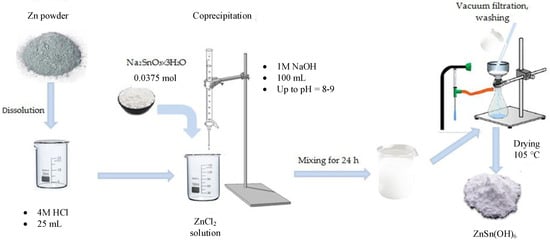
Figure 1.
Synthesis scheme of the precursor.
2.3. Characterization
The microstructure and phase composition of the samples were determined by X-ray diffraction (XRD). X-ray diffraction patterns were recorded at room temperature using a Bruker D8 Advance diffractometer with CuKα radiation in the 2θ range from 10 to 70°. The phases formed in the system were identified using the Crystallographica Search-Match, Version 2.1 program and the PDF4 database. The average crystallite size was estimated from diffraction line broadening in X-ray diffraction patterns using the Scherer formula
where d is the average crystallite size, λ is the X-ray wavelength (1.54051 Å), β is the full width at half maximum of the diffraction peak, θ is the diffraction angle, and k = 0.9. Thermal analysis (TA) of the dried powders was performed on a NETZSCH Jupiter 449C STA synchronous thermal analyzer coupled to QMS 403C Aëolos (TG-QMS) mass spectrometer in an argon flow at temperatures in the range of 20–700 °C at a heating rate of 10 °C/min. The microstructure of the samples was studied by field emission scanning electron microscopy (SEM) using Hitachi SU8000 electron microscope (Tokyo, Japan). The images were taken in the secondary electron recording mode at an accelerating voltage of 2–30 kV and a working distance of 8–10 mm. The sample’s X-ray energy dispersive spectra (EDS) were measured with the use of an Oxford Instruments add-on for electron microscope. Analytical measurements of the EDS were optimized using a previously established method, as outlined in the references [52,59]. Prior to the measurements, the samples were affixed to an aluminum mount with a 25 mm diameter and secured firmly with conductive graphite adhesive tape. Additionally, the morphology of the unmodified samples was studied to preclude any surface effects due to the application of the conductive layer, as noted in [60]. The specific surface area was determined by analyzing the BET isotherms of low-temperature nitrogen adsorption at 77 K using a Quantachrome Nova 1000e static instrument. The pore size distribution was calculated using the Barrett–Joyner–Halenda (BJH) method. The proton conductivity of the composites in the (1–x)CsH2PO4–xZnSnO3 (x = 0.2, 0.4, 0.6, 0.8) system was measured using a two-electrode circuit on alternating current with an Instek LCR-821 impedance meter (12–200 kHz frequency range) and an IPU-1RLC-1/2008 precision electrochemical meter (1 Hz–3.3 MHz frequency range). The composites of the specific compositions were synthesized by thoroughly mixing the components in an agate mortar and heating the pelletized samples at 230–240 °C. Pellets of 6 mm in diameter and 1–1.5 mm thick were pressed from the samples to measure the electrical conductivity, using a pressure of 30–50 MPa. The electrical conductivity of the samples with deposited silver electrodes was measured under cooling conditions at a rate of 1–2 °C/min in an atmosphere with a high water vapor content (10%, 20%, and 30% molar ratio) in the temperature range of 170–250 °C, followed by cooling in air with a relative humidity of 40% [48,52].
3. Results and Discussion
The results from the atomic emission spectrometry analysis showed the minimal residual content of zinc (less 0.1 µg/mL) and tin (less than 0.2 µg/mL) in the mother solution. This indicates that the reaction (2) went to completion, yielding a precipitate with a stoichiometric ratio of Zn:Sn = 1:1. XRD data revealed that the chemical co-precipitation resulted in the formation of zinc hexahydroxostannate ZnSn(OH)6, which possesses a vismirnovite structure with a cubic unit cell and symmetry, space group Pn3m, similar to schoenfliesite [61,62]. The diffraction pattern of the sample is shown in Figure 2 (curve 1).
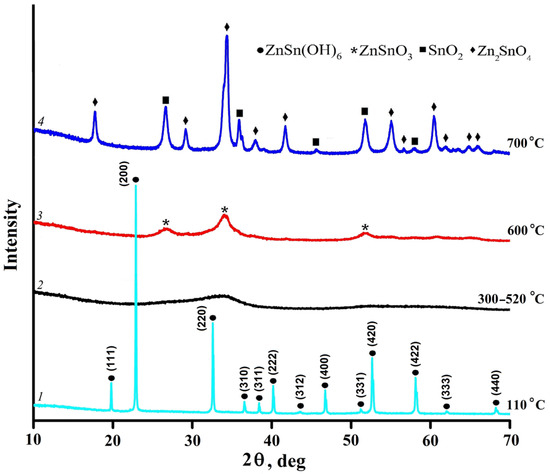
Figure 2.
X-ray diffraction patterns of initial ZnSn(OH)6 (1) and thermolysis products obtained at temperatures of 300–520 °C (2), 600 °C (3), and 700 °C (4).
The value of the lattice parameter, determined using the Rietveld method with Powder Cell 2.4 software, was a = 0.77647 ± 0.00084 nm, and was in good agreement with literature data (a = 0.78 nm [39,62], PDF4, card no. 73-2384). The following reaction results in the formation of ZnSn(OH)6:
ZnCl2 + Na2Sn(OH)6 → ZnSn(OH)6 + 2 NaCl
According to scanning electron microscopy data (Figure 3a), the freshly deposited ZnSn(OH)6 samples were cubic well-grained single crystals of 150–250 nm in size. According to the results of the chemical microanalysis carried out by the EDS method, the Zn:Sn:O atomic ratio fell within the range of (10 ± 1):(10 ± 1):(63 ± 3), which was close to the stoichiometric ratio for ZnSn(OH)6.

Figure 3.
SEM images of freshly deposited ZnSn(OH)6 (a) and after its calcination at 520 °C (b) and 700 °C (c).
According to the thermal analysis data (Figure 4), when ZnSn(OH)6 is heated, successive processes occur, accompanied by changes in the mass, structure, and phase composition, which are consistent with the XRD results. A weight loss of about 18.7% was observed when the sample was heated to a temperature between 50–520 °C, which quantitatively agreed with the calculated value (18.87%) for the reaction:
ZnSn(OH)6 → ZnSnO3 + 3 H2O
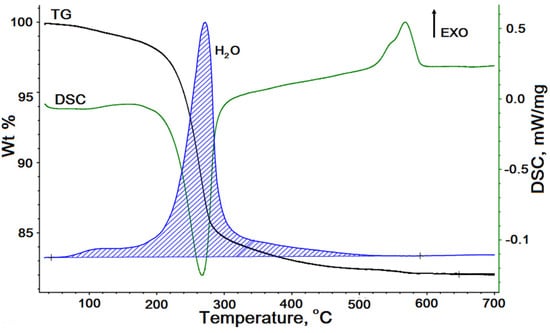
Figure 4.
Synchronous thermal analysis curves obtained during the thermal decomposition of a ZnSn(OH)6 sample: mass change (TG), thermal effects (DSC), and the ionic current of the mass spectrometer measured for the atomic mass number m/z of 18 amu corresponding to water molecules evolving from the sample.
The reaction was accompanied by an endothermic effect with a maximum at Tmax = 268 °C.
According to XRD data, heating ZnSn(OH)6 at 300–520 °C for 4 h produced X-ray amorphous zinc stannate (Figure 2, curve 2). Scanning electron microscopy showed that the dehydrated product was a pseudomorphosis made of nanoparticles of the amorphous phase, retaining the shape and size of the original particles (Figure 3b). At 540–600 °C, an exothermic effect was observed, likely indicating the formation of a weakly crystallized ZnSnO3 phase with a perovskite structure (card 28–1486, PDF4), with the particle size estimated at being 15–20 nm using the Scherrer equation (Figure 2, curve 3). Zinc metastannate is metastable, and the transition to the stable phase Zn2SnO4 with a spinel structure occurred at temperatures above 700 °C, in accordance with the reaction:
2 ZnSnO3 → Zn2SnO4 + SnO2
The annealing at 700 °C resulted in the decomposition of the ZnSnO3 phase into a mixture of the nanocrystalline SnO2 phase with the cassiterite structure (card 71-652, PDF4) and the Zn2SnO4 phase with the spinel structure (card 74–2184, PDF4) (Figure 2, curve 4). Using the Scherrer equation, the estimated size of the nanocomposite particles was less than 60–70 nm for zinc stannate Zn2SnO4 and 20–40 nm for tin dioxide. Scanning electron microscopy showed that the pseudomorphosis of the nanoparticle aggregate was preserved (Figure 3c). However, the large cubic aggregates consisted of the weakly aggregated Zn2SnO4 nanoparticles surrounded by the smaller particles of tin dioxide visible on the surface of the cubic aggregates.
The FTIR spectra analysis of ZnSn(OH)6 and its synthesized compounds showed the structural features and composition, with the characteristic bands assigned based on published data [63,64]. The FTIR spectra of the obtained zinc hydroxtannate ZnSn(OH)6 and zinc stannate ZnSnO3 samples (Figure 5a) matched previous studies [29,49,65].
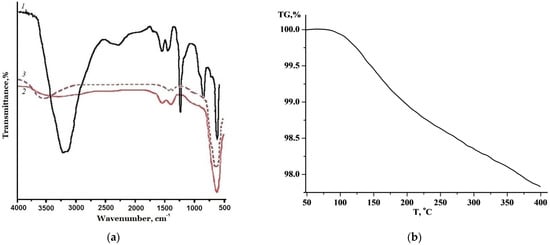
Figure 5.
(a) FTIR spectra of ZnSn(OH)6 (1) and ZnSnO3 obtained by the thermolysis of ZnSn(OH)6 (2) and kept in air for some time (3). (b) Dependence of mass change (TG) of a ZnSnO3 sample after storage in an air atmosphere of a desiccator.
In the spectra, a wide band of ν(OH) stretching vibrations in the 3100–3300 cm−1 region indicated the presence of hydroxyl groups in the precursor and a system of hydrogen bonds in the compound structure. The absorption band at 1180 cm−1 was due to bending vibrations of the Sn–OH bonds, and the moisture deformation vibrations were recorded above 1630 cm−1. These bands decreased with the sample’s dehydration during the heat treatment at 600 °C, which was consistent with the weight loss according to the TG results. In the region of the metal–oxygen bonds (900–400 cm−1) of ZnSnO3, the FTIR spectra showed a strong band at 615 cm−1, corresponding to the symmetric stretching vibrations of the Sn–O bonds (Figure 4a). After holding ZnSnO3 in the air, a broad diffuse absorption band between 3250–3650 cm−1, corresponding to hydrogen bonds and associated with the stretching vibrations ν(H2O), confirmed the sorption of water vapor. The data of the thermal analysis (Figure 5b) for the sample after storage suggested the absorption of water, approximately up to 0.2 mole of H2O, per mole of zinc stannate. The results indicate the reversible sorption of ZnSnO3 water vapor in air and its desorption at elevated temperatures. Similar to ZnSn(OH)6, ZnSnO3 was characterized by the presence of strongly bound adsorbed water molecules.
Table 1 presents the textural properties, specific surface area, and mean pore size of the initial samples and samples calcined at different temperatures for 4 h. High specific surface area values and the presence of mesopores with sizes around 6 nm were characteristics of the samples created during the thermolysis of ZnSn(OH)6. As the heating temperature increased, the specific surface area values monotonically decreased while the pore sizes increased.

Table 1.
Results from the textural study of the initial ZnSn(OH)6 and the products of its thermal decomposition obtained at different temperatures.
As seen from Table 1, the amorphous zinc stannate, obtained by heating at 520 °C, had a higher specific surface area. This high-surface-area zinc stannate, with increased water retention, was used as a heterogeneous additive for CsH2PO4. The proton conductivity and structural properties of the (1–x)CsH2PO4–xZnSnO3 composite system were studied across a range of compositions (x = 0.2–0.8). The XRD patterns indicated no chemical interaction between the components, and the crystalline structure of CsH2PO4 was preserved. The intensity of the reflections corresponding to the LT phase of CsH2PO4 (P2/1m) decreased significantly more than the salt content in the composite (Figure 6a), resulting in a disordered state of CsH2PO4.
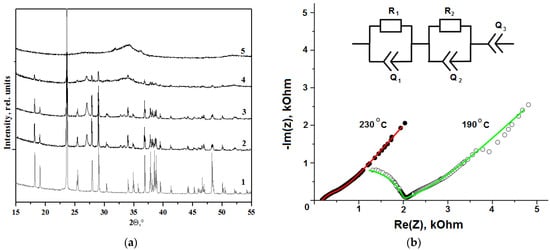
Figure 6.
(a) X-ray diffraction patterns of (1–x)CsH2PO4–xZnSnO3 composites of various compositions in the comparison with the starting compounds: CsH2PO4 (1); x = 0.2 (2); 0.4 (3); 0.8 (4); ZnSnO3 (5). (b) Electrochemical impedance spectra for 0.8CsH2PO4–0.2ZnSnO3 sample obtained at 230 °C (black symbols) and 190 °C (empty symbols). Points are experimental data; lines are theoretical curves obtained for the equivalent circuit, with the parameters listed in Table 2. The parameters of the equivalent scheme are described in detail the texts and Equations (5)–(7).
As the molar percentage of ZnSnO3 increased, an amorphous halo characteristic of zinc stannate appeared in the composite (such as at x = 0.8), and the salt was mostly in an amorphous state.
Figure 6b shows the impedance plots of the composites at different temperatures. The impedance hodograph included an arc that represented the electrode processes in the lower frequency region, and a single semicircle that was due to the electrolyte transfer in the higher frequency region. The proton conductivity was calculated from the resistance values with the minimum capacitive component. As the temperature increased, the radius of the single semicircles significantly decreased, indicating greater proton conductivity due to an increase in the number and mobility of the current carriers. For interpretation of the experimental impedance data, the equivalent circuit presented in Figure 6b was used. The circuit includes three impedances, Z1, Z2, and Z3, connected in series. The first impedance includes the active resistance R1 connected in parallel to the constant phase element (CPE) Q1. The second and third impedances are related to the electrode: R2 and Q2 are charge transfer resistance and CPE taking into account the electrode polarization effects, respectively, and Q3 is the diffusion impedance contribution. As a result, the total impedance of the sample is equal to Z = Z1 + Z2 + Z3, where
As seen from Figure 6b, the theoretical curves obtained for this equivalent circuit fairly fit the experimental data. Results of the fitting are presented in Table 2.

Table 2.
Parameters of the equivalent circuit, R1, Y10, n1, R2, Y20, n2, Y3, and n3, determined by fitting the impedance data.
Figure 7 shows a comparison of the proton conductivity of the samples with the initial salts. The ZnSnO3 matrix initially exhibited a low proton conductivity, not exceeding 2 × 10−8 S/cm in the temperature range below 250 °C. This conductivity was consistent with literature data [40,41,42]. The temperature dependence of the conductivity revealed two regions related to the superprotonic and low temperature phases of CsH2PO4.
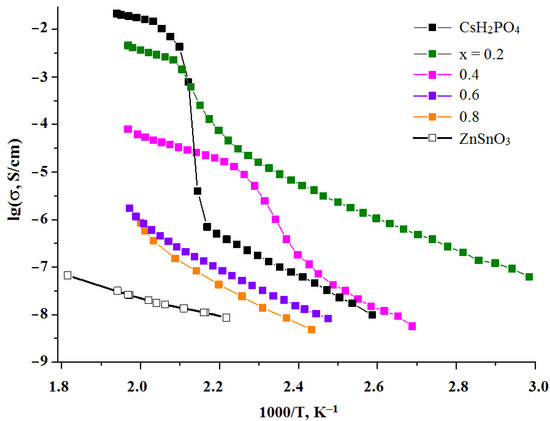
Figure 7.
Temperature dependence of conductivity for composite systems (1–x)CsH2PO4–xZnSnO3 (x = 0.2–0.8) in comparison with CsH2PO4 and ZnSnO3. The conductivity measurement was carried out on two to three pellets with the same composition, but the different size. The relative error in the determining the conductivity is 2–5%.
The proton conductivity of the low temperature phase follows the Arrhenius law, with an activation energy of ~0.9 eV, and does not exceed 3 × 10−7 S/cm at T < 200 °C due to the strong hydrogen bond network that impedes the proton transfer due to the high energy of defect formation. In the CsH2PO4–ZnSnO3 composites, the conductivity can also be distinguished into two temperature ranges. The introduction of small amounts of additives significantly increased the conductivity of the composites in the low-temperature region, with specific conductivity values depending on composition. At x = 0.2, the low-temperature conductivity reached a maximum, increasing by 2.5 orders of magnitude. Consequently, the conductivity jump during the superionic phase transition decreased significantly at x = 0.2. The increase in the conductivity was due to the disordering and partial amorphization of the salt at the interface between the two phases, which occurred as the fraction of additive increased. However, as x further increased to 0.4, the conductivity began to decrease (Figure 8a), despite the volume fraction of the heterogeneous component not exceeding 30%. In the case of x = 0.6, the conductivity in the low-temperature region sharply decreased to values lower than the initial salt due to the percolation effect. The high-temperature region conductivity decreased almost linearly with an increase in the proportion of additive compared with pure CsH2PO4, due to the “conductor–insulator” percolation effect (Figure 8a,b).

Figure 8.
Isotherms of the proton conductivity for the composite systems (1–x)CsH2PO4–xZnSnO3 at different temperatures: 138 °C (a) and 227 °C (b).
Nevertheless, with the addition of small amounts of ZnSnO3, the proton conductivity at high temperatures remained close to the values of the initial salt. In addition, the introduction of a non-conducting matrix led to an increase in the low-temperature conductivity within a specific range of compositions, but reduced the superprotonic conductivity. The composite effects observed in this system were comparable to the conductivity values seen in the CsH2PO4–SrZrO3 and CsH2PO4–NdPO4 systems [48,52], but somewhat lower than for a number of the studied composite systems based on CsH2PO4 [50,51,55,58]. This may be due to an insufficiently high specific surface area and the adhesion energy that determine the interface interaction. Nonetheless, for the samples with the highest proton conductivity values at x = 0.2, the stability of high conductivity values in the superionic region was maintained even with long-term, isothermal exposure at lower partial pressures of water vapor (10% and 20%) due to the higher water retention of the ZnSnO3 matrix. Figure 9 shows the stable conductivity values during the long-term isothermal exposure at the partial water vapor concentration of 10% and 20%, which were lower than those used, in accordance with the phase diagram [43]. The proton conductivity retained unchanged values of 8 × 10−3 S/cm at significantly lower partial pressures of water vapor during 150 min at 230 °C (Figure 9). This was likely due to the presence of adsorbed water in the ZnSnO3 matrix, which was removed at elevated temperatures and prevented dehydration of the CsH2PO4 salt within the composite.
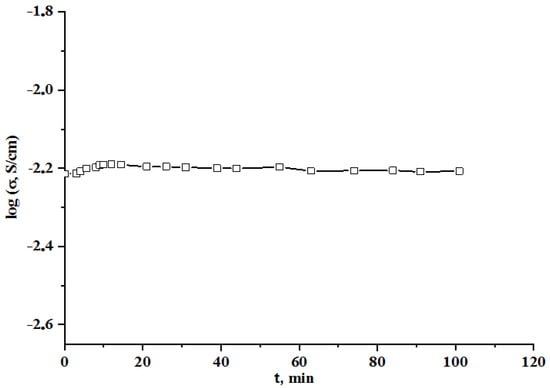
Figure 9.
Dependence of conductivity of (1–x)CsH2PO4–xZnSnO3 (x = 0.2) system on the time of long-term storage at 230 °C (water vapor content was 20 mol%).
4. Conclusions
In this work, the synthesis and the thermal decomposition of zinc hydroxostannate were studied in detail. ZnSn(OH)6 with the cubic crystals of 150–250 nm in size was synthesized by hydrolytic precipitation from the solutions of ZnCl2 and Na2SnO3. Zinc stannate with a high specific surface area (85 m2/g) was formed through the thermolysis of ZnSn(OH)6 in the temperature range of 300–520 °C. A weakly crystallized ZnSnO3 phase with a particle size of 15–20 nm was formed at 540–600 °C, while at an annealing temperature of 700 °C, a mixture of nanocrystalline SnO2 with the cassiterite structure (20–40 nm) and Zn2SnO4 (less than 60–70 nm) with the spinel structure was formed. As a result of the thermolysis study, optimal conditions for the formation of highly-dispersed zinc stannate were found, and the obtained materials were further used for the creation of the composite solid electrolytes.
The proton conductivity of the composite systems with the compositions of (1–x)CsH2PO4–xZnSnO3 (x = 0.2–0.8) was studied. The CsH2PO4 crystal structure remained in the composite systems, but dispersion and partial salt amorphization were observed due to the interface interaction with the ZnSnO3 matrix. As a result, the conductivity in the low-temperature region increased up to 2.5 orders of magnitude, went through a smooth maximum at x = 0.2, and then decreased due to the percolation “conductor–isolator” effect. The samples with the highest proton conductivity at x = 0.2 demonstrated stable high conductivity values (8 × 10−3 S/cm) under long-term isothermal exposure (150 min at 230 °C) at lower partial pressures of water vapor. This will allow this material to be used in electrochemical applications. Thus, it has been demonstrated that X-ray amorphous zinc stannate ZnSnO3 is a suitable heterogeneous additive in other composite solid electrolytes. The composite solid electrolytes CsH2PO4–ZnSnO3 may be used as solid electrolyte membrane materials in intermediate temperature electrochemical resistors for hydrogen production. Such an approach might be competitive compared with alternative hydrogen production techniques [66,67,68,69,70].
Author Contributions
A.I.A., A.G.B. and A.M.: investigation, methodology, data curation, and writing—original draft. A.V.L., N.U., V.V.G. and A.S.A.-Q.: investigation, data curation, and methodology: conceptualization, paper revision, and English correction; V.P.: writing—review and editing. I.B.: methodology and investigation. All authors have read and agreed to the published version of the manuscript.
Funding
The work was supported by the Russian Federation Ministry of Science and Higher Education (state research target, project no. FSUN-2023-0008).
Institutional Review Board Statement
Not applicable.
Informed Consent Statement
Not applicable.
Data Availability Statement
The data is available from corresponding author upon a reasonable request.
Conflicts of Interest
The authors declare no conflict of interest.
References
- Wang, Y.; Li, D.; Liu, Y.; Zhang, J. Fabrication of novel rugby-like ZnSnO3/reduced graphene oxide composites as a high-performance anode material for lithium-ion batteries. Mater. Lett. 2016, 167, 222–225. [Google Scholar] [CrossRef]
- Ma, Y.; Xie, Q.; Liu, X.; Zhao, Y.; Zeng, D.; Wang, L.; Zheng, Y.; Peng, D.L. Synthesis of amorphous ZnSnO3 double-shell hollow microcubes as advanced anode materials for lithium ion batteries. Electrochim. Acta 2015, 182, 327–333. [Google Scholar] [CrossRef]
- Wei, J.L.; Jin, X.Y.; Yu, M.C.; Wang, L.; Guo, Y.H.; Dong, S.T.; Zhang, Y.M. Electrospun ZnSnO3/C nanofibers as an anode material for lithium-ion batteries. J. Electron. Mater. 2021, 50, 4945–4953. [Google Scholar] [CrossRef]
- Nalimova, S.S.; Maksimov, A.I.; Matyushkin, L.B.; Moshnikov, V.A. Current state of studies on synthesis and application of zinc stannate. Glas. Phys. Chem. 2019, 45, 251–260. [Google Scholar] [CrossRef]
- Sim, C.K.; Majid, S.R.; Mahmood, N.Z. Synthesis of highly porous carbon/ZnSnO3 composite and its electrochemical properties. J. Energy Storage 2020, 32, 101843. [Google Scholar] [CrossRef]
- Sim, C.K.; Majid, S.R.; Mahmood, N.Z. ZnSnO3/mesoporous biocarbon composite towards sustainable electrode material for energy storage device. Microchem. J. 2021, 164, 105968. [Google Scholar] [CrossRef]
- Yan, S.; Zhang, S.Z.; Xie, W.F.; Gai, L.Y.; Yuan, H.M.; Zhang, D.; Zhang, H.; Liu, X.; Yang, W.; Chi, Z.T. Chemiresistive ethanol sensors based on In2O3/ZnSnO3 nanocubes. Sens. Actuators Rep. 2022, 4, 100099. [Google Scholar] [CrossRef]
- Feng, G.; Che, Y.; Song, C.; Xiao, J.; Fan, X.; Sun, S.; Huang, G.; Ma, Y. Morphology-controlled synthesis of ZnSnO3 hollow spheres and their n-butanol gas-sensing performance. Ceram. Int. 2021, 47, 2471–2482. [Google Scholar] [CrossRef]
- Guo, W.; Zhao, B.; Huang, L.; He, Y. One-step synthesis of ZnWO4/ZnSnO3 composite and the enhanced gas sensing performance to formaldehyde. Mater. Lett. 2020, 277, 4–7. [Google Scholar] [CrossRef]
- Zeng, Y.; Zhang, K.; Wang, X.; Sui, Y.; Zou, B.; Zheng, W.; Zou, G. Rapid and selective H2S detection of hierarchical ZnSnO3 nanocages. Sens. Actuators B Chem. 2011, 159, 245–250. [Google Scholar] [CrossRef]
- Nalimova, S.S.; Shomakhov, Z.V.; Punegova, K.N.; Ryabko, A.A.; Maksimov, A.I. Synthesis and study of gas-sensitive nanostructures of the Zn-Sn-O system. Phys. Chem. Asp. Study Clust. Nanostruct. Nanomater. 2021, 13, 910–918. [Google Scholar] [CrossRef]
- Sá, B.S.; Zito, C.A.; Perfecto, T.M.; Volanti, D.P. Porous ZnSnO3 nanocubes as a triethylamine sensor. Sens. Actuators B Chem. 2021, 338, 129869. [Google Scholar] [CrossRef]
- Gao, X.; Wang, Y.; Wang, Q.; Wu, X.; Zhang, W.; Luo, C. Facile synthesis of hollow cube-like ZnSnO3 wrapped by nitrogen-doped graphene: As a high-performance and enhanced synergistic microwave absorber. J. Magn. Magn. Mater. 2019, 486, 165251. [Google Scholar] [CrossRef]
- Zhou, T.T.; Zhang, T.; Zhang, R.; Lou, Z.; Deng, J.N.; Wang, L.L. Hollow ZnSnO3 cubes with controllable shells enabling highly efficient chemical sensing detection of formaldehyde vapors. ACS Appl. Mater. Interfaces. 2017, 9, 14525–14533. [Google Scholar] [CrossRef] [PubMed]
- Liu, K.; Zheng, Z.; Xu, J.; Zhang, C. Enhanced visible light-excited ZnSnO3 for room temperature ppm-level CO2 detection. J. Alloys Compd. 2022, 907, 164440. [Google Scholar] [CrossRef]
- Zhang, J.; Jia, X.; Lian, D.; Yang, J.; Wang, S.; Li, Y.; Song, H. Enhanced selective acetone gas sensing performance by fabricating ZnSnO3/SnO2 concave microcube. Appl. Surf. Sci. 2021, 542, 148555. [Google Scholar] [CrossRef]
- Yin, Y.; Shen, Y.; Zhou, P.; Lu, R.; Li, A.; Zhao, S.; Liu, W.; Wei, D.; Wei, K. Fabrication, characterization and n-propanol sensing properties of perovskite-type ZnSnO3 nanospheres based gas sensor. Appl. Surf. Sci. 2020, 509, 145335. [Google Scholar] [CrossRef]
- Zeng, Y.; Wang, X.; Zheng, W. Synthesis of novel hollow ZnSnO3 cubic nanocages and their HCHO sensing properties. J. Nanosci. Nanotechnol. 2013, 13, 1286–1290. [Google Scholar] [CrossRef]
- Song, P.; Wang, Q.; Yang, Z. Ammonia gas sensor based on PPy/ZnSnO3 nanocomposites. Mater. Lett. 2011, 65, 430–432. [Google Scholar] [CrossRef]
- Zhang, Y.; Liu, Y.; Wang, L.; Zhou, H.; Meng, W.; Li, Y.; He, Z.; Dai, L. A mixed-potential type NH3 sensors based on spinel Zn2SnO4 sensing electrode. Sens. Actuators B Chem. 2022, 367, 132154. [Google Scholar] [CrossRef]
- Arora, I.; Praveen, K. Effect of annealing temperature on structure-property correlations in Zn2SnO4 nanostructured films for optoelectronics. Mater. Res. Express. 2020, 7, 035023. [Google Scholar] [CrossRef]
- Rembeza, S.I.; Belousov, S.A.; Kosheleva, N.N.; Rembeza, E.S.; Svistova, T.V.; Suvaci, E.; Özel, E.; Tuncolu, G.; Açiksari, C. Amorphous films of ternary zinc and tin oxides for transparent electronics. Tech. Phys. Lett. 2018, 44, 984–987. [Google Scholar] [CrossRef]
- Gnanamoorthy, G.; Yadav, V.K.; Latha, D.; Karthikeyan, V.; Narayanan, V. Enhanced photocatalytic performance of ZnSnO3/rGO nanocomposite. Chem. Phys. Lett. 2020, 739, 137050. [Google Scholar] [CrossRef]
- Dong, S.; Cui, L.; Zhang, W.; Xia, L.; Zhou, S.; Russell, C.K.; Fan, M.; Feng, J.; Sun, J. Double-shelled ZnSnO3 hollow cubes for efficient photocatalytic degradation of antibiotic wastewater. Chem. Eng. J. 2020, 384, 123279. [Google Scholar] [CrossRef]
- Habibi, M.H.; Mardani, M. Synthesis and characterization of bi-component ZnSnO3/Zn2SnO4 (perovskite/spinel) nano-composites for photocatalytic degradation of Intracron Blue: Structural, opto-electronic and morphology study. J. Mol. Liq. 2017, 238, 397–401. [Google Scholar] [CrossRef]
- Guo, F.; Huang, X.; Chen, Z.; Ren, H.; Li, M.; Chen, L. MoS2 nanosheets anchored on porous ZnSnO3 cubes as an efficient visible-light-driven composite photocatalyst for the degradation of tetracycline and mechanism insight. J. Hazard. Mater. 2020, 390, 122158. [Google Scholar] [CrossRef]
- Kumar, A.; Mathur, L.; Bae, H.; Sim, U.K.; Song, S.J. Design of Novel transition metal based multiphase stannate: An efficient electrocatalyst for oxygen evolution reaction. Mater. Chem. Phys. 2022, 279, 125613. [Google Scholar] [CrossRef]
- Anisimov, V.V.; Saprykin, A.V.; Artemkina, I.M.; Makarov, N.A. Influence of the anionic composition of initial salts on obtaining zinc orthostannate by the sol-gel method. Glas. Ceram. 2021, 78, 148–152. [Google Scholar] [CrossRef]
- Venkatesan, R.; Zhang, Y.; Chen, G. Preparation of poly(butylene adipate-co-terephthalate)/ZnSnO3 composites with enhanced antimicrobial activity. Compos. Commun. 2020, 22, 100469. [Google Scholar] [CrossRef]
- Wang, D.; Pu, X.; Yu, X.; Bao, L.; Cheng, Y.; Xu, J.; Han, S.; Ma, Q.; Wang, X. Controlled preparation and gas sensitive properties of two-dimensional and cubic structure ZnSnO3. J. Colloid Interface Sci. 2022, 608, 1074–1085. [Google Scholar] [CrossRef]
- Ge, Q.; Liu, C.; Zhao, Y.; Wang, N.; Zhang, X.; Feng, C.; Zhang, S.; Wang, H.; Jiang, W.; Liu, S.; et al. Phase evolution in preparing ZnSnO3 powders by precipitation method. Appl. Phys. A Mater. Sci. Process. 2021, 127, 89. [Google Scholar] [CrossRef]
- Sidorak, A.V.; Shubin, A.A.; Ivanov, V.V.; Nikolayeva, N.S. Some Aspects of Zn2SnO4 Powders Synthesis by Thermotreatment of Coprecipitated Compounds. J. Siberian Federal Univ. Chem. 2010, 26, 1343–1348. [Google Scholar]
- Loginov, A.V.; Bagavieva, S.K.; Aparnev, A.I.; Uvarov, N.F. Synthesis of oxide materials in the Mg–Sn–O system for use in composite solid electrolytes. Russ. J. Appl. Chem. 2017, 90, 496–498. [Google Scholar] [CrossRef]
- Loginov, A.V.; Mateyshina, Y.G.; Aparnev, A.I.; Uvarov, N.F. Synthesis of BaSnO3/SnO2 nanocomposites as heterogeneous additive for composite solid electrolytes. Russ. J. Appl. Chem. 2018, 91, 1660–1664. [Google Scholar] [CrossRef]
- Loginov, A.V.; Aparnev, A.I.; Uvarov, N.F. Synthesis of SrSnO3/SnO2 composites via thermal decomposition of a precursor. Inorg. Mater. 2022, 58, 420–424. [Google Scholar] [CrossRef]
- Loginov, A.V.; Aparnev, A.I.; Uvarov, N.F. Nanocomposites Prepared via Thermal Decomposition of Calcium Hydroxystannate CaSn(OH)6. Inorg. Mater. 2022, 58, 814–821. [Google Scholar] [CrossRef]
- Jiang, L.; Xue, K.; Chen, Z.; Cui, Q.; Xu, S. Hydrothermal synthesis of ZnSnO3/rGO composite material and highly gas sensing performance to acetone. Mater. Sci. Semicond. Process. 2021, 134, 106051. [Google Scholar] [CrossRef]
- He, Q.; Zi, J.; Huang, B.; Yan, L.; Fa, W.; Li, D.; Zhang, Y.; Gao, Y.; Zheng, Z. Controlled growth and thermal decomposition of well-dispersed and uniform ZnSn(OH)6 submicrocubes. J. Alloys Compd. 2014, 607, 193–197. [Google Scholar] [CrossRef]
- Fu, X.; Huang, D.; Qin, Y.; Li, L.; Jiang, X.; Chen, S. Effects of preparation method on the microstructure and photocatalytic performance of ZnSn(OH)6. Appl. Catal. B Environ. 2014, 148–149, 532–542. [Google Scholar] [CrossRef]
- Baranov, A.I.; Khiznichenko, V.P.; Sandur, V.A.; Shuvalov, L.A. Frequency dielectric dispersion in the ferroelectric and superionic phases of CsH2PO4. Ferroelectrics 1988, 81, 183–186. [Google Scholar] [CrossRef]
- Matsunaga, H.; Itoh, K.; Nakamura, E. X-ray structural study of CDP at room temperature. J. Phys. Soc. Japan 1980, 48, 2011–2014. [Google Scholar] [CrossRef]
- Baranov, A.I. Crystals with disordered hydrogen-bond networks and superprotonic conductivity. Rev. Crystallogr. Rep. 2003, 48, 1012–1037. [Google Scholar] [CrossRef]
- Taninouchi, Y.K.; Uda, T.; Awakura, Y.; Ikeda, A.; Haile, S.M. Dehydration behavior of the superprotonic conductor CsH2PO4 at moderate temperatures: 230 to 260 °C. J. Mater. Chem. 2007, 17, 3182–3189. [Google Scholar] [CrossRef]
- Boysen, D.A.; Uda, T.; Chisholm, C.R.I.; Haile, S.M. High-performance solid acid fuel cells through humidity stabilization. Sci. 2004, 303, 68–70. [Google Scholar] [CrossRef] [PubMed]
- Uda, T.; Haile, S.M. Thin-membrane solid-acid fuel cell. Electrochem. Solid-State Lett. 2005, 8, 245–246. [Google Scholar] [CrossRef]
- Baranov, A.I.; Grebenev, V.V.; Khodan, A.N.; Dolbinina, V.V.; Efremova, E.P. Optimization of superprotonic acid salts for fuel cell applications. Solid State Ionics. 2005, 176, 2871–2874. [Google Scholar] [CrossRef]
- Ponomareva, V.G.; Lavrova, G.V. Controlling the proton transport properties of solid acids via structural and microstructural modification. J. Solid State Electrochem. 2011, 15, 213–221. [Google Scholar] [CrossRef]
- Anfimova, T.; Jensen, A.H.; Christensen, E.; Jensen, J.O.; Bjerrum, N.J.; Li, Q. CsH2PO4/NdPO4 composites as proton conducting electrolytes for intermediate temperature fuel cells. J. Electrochem. Soc. 2015, 162, F436–F441. [Google Scholar] [CrossRef]
- Qing, G.; Kikuchi, R.; Takagaki, A.; Sugawara, T.; Oyama, S.T. CsH2PO4/Polyvinylidene Fluoride Composite Electrolytes for Intermediate Temperature Fuel Cells. J. Electrochem. Soc. 2014, 161, 451–457. [Google Scholar] [CrossRef]
- Muroyama, H.; Matsui, T.; Kikuchi, R.; Eguchi, K. Electrochemical hydrogen production from carbon monoxide and steam with a cell employing CsH2PO4/SiP2O7 composite electrolyte. J. Electrochem. Soc. 2009, 156, 1389. [Google Scholar] [CrossRef]
- Ponomareva, V.G.; Lavrova, G.V. New type of composite proton electrolytes based on CsH2PO4 synthesized by mechanical activation. Mater. Today Proc. 2019, 12, 9–12. [Google Scholar] [CrossRef]
- Lavrova, G.V.; Shutova, E.S.; Ponomareva, V.G.; Dunyushkina, L.A. Proton conductivity and interphase interaction in CsH2PO4-SrZrO3 composites. Russ. J. Electrochem. 2013, 49, 718–724. [Google Scholar] [CrossRef]
- Bagryantseva, I.N.; Ponomareva, V.G.; Lazareva, N.P. Proton-conductive membranes based on CsH2PO4 and ultra-dispersed polytetrafluoroethylene. Solid State Ion. 2019, 329, 61–66. [Google Scholar] [CrossRef]
- Bagryantseva, I.N.; Gaydamaka, A.A.; Ponomareva, V.G. Intermediate temperature proton electrolytes based on cesium dihydrogen phosphate and Butvar polymer. Ionics 2020, 26, 1813–1818. [Google Scholar] [CrossRef]
- Ponomareva, V.G.; Bagryantseva, I.N.; Shutova, E.S. Hybrid systems based on nanodiamond and cesium dihydrogen phosphate. Mater. Today Proc. 2020, 25, 521–524. [Google Scholar] [CrossRef]
- Bagryantseva, I.N.; Ponomareva, V.G.; Khusnutdinov, V.R. Intermediate temperature proton electrolytes based on cesium dihydrogen phosphate and poly (vinylidene fluoride-co-hexafluoropropylene). J. Mater. Sci. 2021, 56, 14196–14206. [Google Scholar] [CrossRef]
- Bagryantseva, I.N.; Kungurtsev, Y.E.; Dormidonova, D.O.; Ponomareva, V.G. Composite electrolytes based on cesium dihydrophosphate and fluoropolymers. Russ. J. Electrochem. 2022, 58, 611–616. [Google Scholar] [CrossRef]
- Ponomareva, V.G.; Shutova, E.S.; Kovalenko, K.A.; Fedin, V.P. New type of nanocomposite CsH2PO4-UiO-66 Electrolyte with High Proton Conductivity. Molecules 2022, 27, 8387. [Google Scholar] [CrossRef]
- Kachala, V.V.; Khemchyan, L.L.; Kashin, A.S.; Orlov, N.V.; Grachev, A.A.; Zalesskiy, S.S.; Ananikov, V.P. Target-oriented analysis of gaseous, liquid and solid chemical systems by mass spectrometry, nuclear magnetic resonance spectroscopy and electron microscopy. Russ. Chem. Rev. 2013, 82, 648–685. [Google Scholar] [CrossRef]
- Kashin, A.S.; Ananikov, V.P. A SEM study of nanosized metal films and metal nanoparticles obtained by magnetron sputtering. Russ. Chem. Bull. 2011, 60, 2602–2607. [Google Scholar] [CrossRef]
- Dong, S.; Cui, L.; Zhao, Y.; Wu, Y.; Xia, L.; Su, X.; Zhang, C.; Wang, D.; Guo, W.; Sun, J. Crystal structure and photocatalytic properties of perovskite MSn(OH)6 (M = Cu and Zn) composites with d10 -d10 configuration. Appl. Surf. Sci. 2019, 463, 659–667. [Google Scholar] [CrossRef]
- Faust, G.T.; Schaller, W.T. Schoenfliesite, MgSn(OH)6. Schoenfliesite 1971, 141, 116–141. [Google Scholar]
- Nakamoto, K. Infrared and Raman Spectra of Inorganic and Coordination Compounds; Wiley: New York, NY, USA, 1997; Volume 479. [Google Scholar]
- Socrates, G. Infrared and Raman Characteristic Group Frequencies Contents, Tables and Charts; John Wiley & Sons. Inc.: Hoboken, NJ, USA, 2001. [Google Scholar]
- Yasser, H.; Rodriguez-Paez, J.E.; Gutierrez, R.M. Structural and optical study of perovskite nanoparticles MSnO3 (M = Ba, Zn, Ca) obtained by a wet chemical route. Mater. Chem. Phys. 2021, 266, 124557. [Google Scholar] [CrossRef]
- Tayyab, M.; Liu, Y.; Liu, Z.; Pan, L.; Xu, Z.; Yue, W.; Zhou, L.; Lei, J.; Zhang, J. One-pot in-situ hydrothermal synthesis of ternary In2S3/Nb2O5/Nb2C Schottky/S-scheme integrated heterojunction for efficient photocatalytic hydrogen production. J. Colloid Interface Sci. 2022, 628 Pt B, 500–512. [Google Scholar] [CrossRef]
- Tayyab, M.; Liu, Y.; Min, S.; Irfan, R.M.; Zhu, Q.; Zhou, L.; Lei, J.; Zhang, J. Simultaneous hydrogen production with the selective oxidation of benzyl alcohol to benzaldehyde by a noble-metal-free photocatalyst VC/CdS nanowires. Chin. J. Catal. 2022, 43, 1165–1175. [Google Scholar] [CrossRef]
- Liu, G.; Feng, M.; Tayyab, M.; Gong, J.; Zhang, M.; Yang, M.; Lin, K. Direct and efficient reduction of perfluorooctanoic acid using bimetallic catalyst supported on carbon. J. Hazard. Mater. 2021, 412, 125224. [Google Scholar] [CrossRef] [PubMed]
- Danish, M.; Tayyab, M.; Akhtar, A.; Kausar, S.; Ullah, S.; Iqbal, M. Effect of soft template variation on the synthesis, physical, and electrochemical properties of Mn3O4 nanomaterial. Inorg. Nano-Met. Chem. 2021, 51, 359–365. [Google Scholar] [CrossRef]
- Tayyab, M.; Liu, Y.; Liu, Z.; Xu, Z.; Yue, W.; Zhou, L.; Lei, J.; Zhang, J. A new breakthrough in photocatalytic hydrogen evolution by amorphous and chalcogenide enriched cocatalysts. Chem. Eng. J. 2023, 455, 140601. [Google Scholar] [CrossRef]
Disclaimer/Publisher’s Note: The statements, opinions and data contained in all publications are solely those of the individual author(s) and contributor(s) and not of MDPI and/or the editor(s). MDPI and/or the editor(s) disclaim responsibility for any injury to people or property resulting from any ideas, methods, instructions or products referred to in the content. |
© 2023 by the authors. Licensee MDPI, Basel, Switzerland. This article is an open access article distributed under the terms and conditions of the Creative Commons Attribution (CC BY) license (https://creativecommons.org/licenses/by/4.0/).